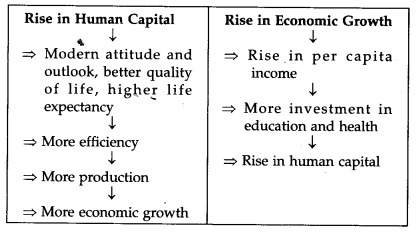NCERT Solutions for Class 11 Economics Chapter 5 – Human Capital Formation in India
Question 1. What are the two major sources of human capital in a country?
Answer. Two main sources of human capital are an investment in education and health.
Question 2. What are the indicators of educational achievement in a country?
Answer. Educational attainment is measured by primary education, youth literacy and adult literacy.
Question 3. Why do we observe regional differences in educational attainment in India?
Answer. Regional differences in educational attainment in India is due to :
- inequality of income
- expenditure by the government in education facilities.
Question 4.Bring out the differences between human capital and human development.
Answer.Difference between Human Capital and Human Development
Human Capital
1. Human capital considers education and health as a means to increase labour productivity.
2. Human capital is a narrow concept which treats human beings as a means to achieve an end which is higher productivity, failing which the investment is not considered to be productive.
Human Development
1. Human development is based on the idea that education and health are integral to human well-being since only when people have the ability to read and apply their knowledge to derive maximum benefit they will be able to lead a long and healthy life.
2. Human development is a broader concept which considers human beings as ends in themselves. Human welfare can be achieved through investments in education and health. It considers welfare — a right of every individual irrespective of their contribution to labour productivity. Every individual has right to be literate and lead a healthy life.
Question 5.How is human development a broader term as compared to human capital?
Answer.
- Human capital is a narrow concept which treats human beings as a means to achieve an end which is higher productivity, failing which the investment is not considered to be productive.
- Human development is a broader concept which considers human beings as ends in themselves. Human welfare can be achieved through investments in education and health. It considers welfare—a right of every individual irrespective of their contribution to labour productivity. Every individual has right to be literate and lead a healthy life.
Question 6.What factors contribute to human capital formation?
Answer.Sources of Human Capital Formation :
- Expenditure on Education
- Training
- Expenditure on Health
- Migration
- Expenditure on Information.
Question 7. Mention two government organisations each that regulate the health and education sectors.
Answer.In India, the ministries of education at the Centre and State level, departments of education and
various organisations such as National Council of Educational Research and Training (NCERT),
University Grants Commission (UGC) and All India Council of Technical Education (AICTE) regulate the education sector. Similarly, the ministries of health at the Union and State level, departments of health and various organisations like Indian Council for Medical Research (ICMR) regulate the health sector.
Question 8. Education is considered an important input for the development of a nation. How?
or
Examine the role of education in the economic development of a nation.
Answer. Expenditure on education is an important source of capital formation. Education is an important source of human capital formation, because:
- It generates technical skills and creates a manpower which is suited for improving labour productivity. It, thus, results in sustained economic development.
- It tends to bring down birth rate which, in turn, brings decline in population growth rate. It makes more resources available per person.
- It results in social benefits since it spreads to others who may not be skilled. Thus, investment in education leads to higher returns in future.
Question 9. Discuss the following’as a sources of human capital formation
(a) Health infrastructure
(b) Expenditure on migration.
Answer.
- Health Infrastructure. Health is another important source of human capital formation. Preventive medicine (vaccination), curative medicine (medical intervention during illness), social medicine (spread of health literacy) and provision of clean drinking water and good sanitation are the various forms of health expenditure. Health expenditure directly increases the supply of healthy labour force and is, thus, a source of human capital formation.
- Migration. People sometimes migrate from one place to the other in search of better job. It includes
migration of people from rural areas to urban areas in India and migration of technical personnel from India to qther countries of the world. Migration in both these cases involves cost of transport, higher cost of living in the migrated places and psychic costs of living in a strange socio-cultural set-up. The enhanced earnings in the new place outweigh the costs of migration. Expenditure on migration is also a source of capital formation.
Question 10. Establish the need for acquiring information relating to health and education expenditure for the effective utilisation of human resources.
Answer. People need to have information on the cost and benefit of investment in health and education. When people know the benefits of their investment in these two areas, they make more expenditure. The result is more human capital formation.
Question 11. How does investment in human capital contribute to growth?
Answer. Role of Human Capital Formation in Economic Growth:
- Raises Production .
- Raises Efficiency and Productivity
- Brings Positive Changes in Outlook and Attitudes
- Improves Quality of Life
- Raises Life Expectancy
- Raises Social Justice.
Question 12. ‘There is a downward trend in inequality world-wide with a rise in the average education levels.Comment.
Answer. This is true, because education makes everyone equal and they earn similar salaries. It reduces inequalities of income world wide.
Question 13. Explain how investment in education stimulates economic growth. (or)
Explain the role of education in the development of a country.
Answer. Education is an important source of human capital formation. Investment in education stimulates economic development in the following ways:
- Raises production. Knowledgeable and skilled workers can make better use of resources at their disposal. It will increase production in the economy. An educated and trained person can apply his knowledge and skill at farm, factory and office to increase production.
- Raises efficiency and productivity. Investment in education increases efficiency and productivity, and hence yields higher income to the people.
- Brings positive changes in outlook and attitudes. Knowledgeable and skilled people have modem outlook and attitudes, that they make rational choice in respect of places and jobs.
- Improves quality of life. Education improves quality of life as it provides better job, high income and improves health. It results in better standard of living.
Question 14. Bring out the need forjm-the-j ob-training for a person.
Answer. Technical training adds to the capacity of the people to produce more. Firms given on-the-job- training to enhance the productive skills of the workers so as to enable them to absorb new technologies and modem ideas. It can be given in two forms:
- The workers may be trained in the firm itself under the assistance of a senior and experienced worker.
- The workers may be sent off the firm campus for the training.
Question 15. Trace the relationship between human capital and economic growth.
Answer. Human capital formation raises the process of economic growth and economic growth raises the process of human capital formation. There is a cause and effect relationship between human capital and economic growth. It is shown in the figure.
Question 16. Discuss the need for promoting women’s education in India.
Answer. Women Education Council has been set up to provide technical education to the women. It has
set up many women polytechnics. It is essential to promote women’s education in India to:
- improve women’s economic independence and their social status.
- make a favourable impact on fertility rate and health care of women and children.
Question 17. Argue in favour of the need for different forms of government intervention in education and health sectors.
Answer. Government intervention in education and health sectors is necessary because of the following reasons:
- Education and health care services create both private as well as social benefits. Both private and public institutions are needed to provide these services and government must keep its control on them.
- Expenditure on education and health institutes are important for the growth of a nation. The private providers of education and health services need to be regulated by the government.
Question 18. What are the main problems of human capital formation in India?
Answer. Main problems of human capital formation in India are:
- Rising Population. Rapidly rising population adversely affects the quality of human capital formation in developing countries. It reduces per capita availability of existing facilities. A large population requires huge investment in education and health. This diverts the scarce money to production of human capital at the cost of physical capital.
- Long Term Process. The process of human development is a long term policy because skill formation takes time. The process which produces skilled manpower is thus slow.
- High Regional and Gender Inequality. Regional and gender inequality lowers the human development levels.
- Brain Drain. Migration of highly skilled labour termed as “Brain Drain” adversely affects the economic development.
- Insufficient on-the-job-training in agriculture. Agriculture sector is neglected where the workers are not given on-the-job training to absorb emerging new technologies.
- High Poverty Levels. A large proportion of the population lives below poverty line and do not have access to basic health and educational facilities. A large section of society cannot afford to get higher education or expensive medical treatment for major disease.
Question 19. In your view, is it essential for the government to regulate the fee structure in education and health care institutions? If so, why?
Answer. Yes, government intervention is necessary in regulating the fee structure in education and health care institutions:
- to maintain uniformity
- to have accountability
- to help poorer people.




